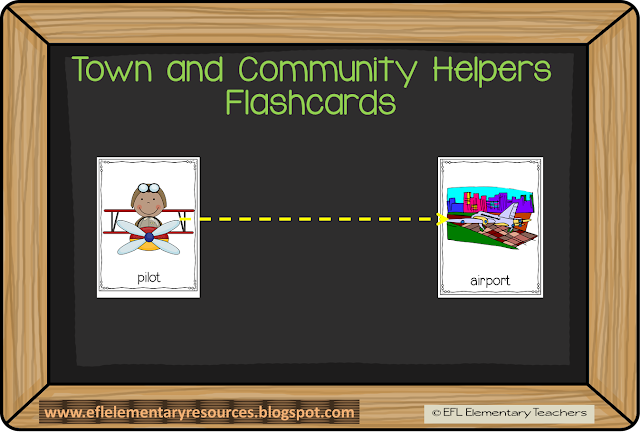The resource contains a wealth of printable material.Link to the complete Clothes Unit resource:
Watch the video of the complete resource:
I am adding even more ideas and activities for the clothes theme from a previous post. Link to check: http://eflelementaryresources.blogspot.com/2017/01/clothes-resources-for-elementary-ell.html
Starting
with flashcards for the clothes unit to promote the use of spontaneous language.
Have two
students stand in front of the class with two
flashcards.
Teacher: Look at the
skirt. It´s Karen´s skirt.
(Point to the skirt and the girl)
Teacher: Look at the shirt. It´s Henry´s shirt. (Point
to the shirt and the boy)
Name a
piece of clothing and the students say who they belong.
Teacher: dress!
Students: It´s Karen´s
dress!
Teacher: Whose sweater is
this?
Ask Henry and Karen questions.
Teacher: Henry, What
clothes do you have?
Henry: I have a white shirt
and a brown sweater.
Place 4 Flashcards on the board and write a name for each one.
Teacher: Who has a blue
jacket?
Students: Carlos! Carlos
has a blue jacket.
Teacher: Who has a green
skirt?
Students: Ellen! Ellen
has a green skirt.
Make sentences.
Teacher: Ellen has a green coat. She has a yellow blouse.
She has a green skirt and green shoes. She has a pink purse.
Play a guessing game.
Put up 10 flashcards on the board. Write a number under each one. I used
counting by 10s.
Have the
students guess which card is the selected one by you.
Students: Is the person wearing a dress ?
Teacher: No!
Students: Is the person wearing pants ?
Teacher: No!
Students: Is the person wearing a skirt ?
Teacher: YES!
Students: Is the person wearing a long skirt ?
Teacher: YES!
Students: Is the person wearing a hat ?
Teacher: YES!
Students: It´s number 40 !
Teacher: YES!
Numbers.
Place several flashcards on the
board and write a number word under each clothing item. Hand in the Number Flashcards
1 to 20 and have them look for their number word and place the flashcard where
it belongs.
Student: The blouse is number 20.
Sort by season! Place the 4 Seasons flashcards on the board. Hand in all
the clothing flashcards and designate a group for each Season. Students have to
sort the flashcards and place them in the Season where they belong as in a mind map.
Students: It´s Spring. We can wear a cap and jeans.
Moving on
to activities and worksheets.
Magazine pictures. Have the children choose
pictures from magazines. Have them write 5 sentences for each pictures on a
separate paper. You choose more pictures
to add interest and difficulty. Place the pictures on the board and hand in the
texts with the sentences to random students. At your signal they all stand with
their assigned text and find the picture that matches their text.
Create your sweater. Have the students color the
sweater they chose. They can add as many details they want. Then, cut out the
sweater and be ready to compare with other students. Have them add a price tag.
Perfect for adjectives.
Teacher: My sweater is the biggest.
Student 1: My sweater is the smallest.
Student 2: My sweater is more expensive than Pedro´s.
Ask questions.
Teacher: How much is the
green sweater?
Student: It´s 10 $.
Teacher: Tomas, is this sweater yours?
Student: Yes, it is.
I added the frog and clothes worksheets from my weather blog post. Have the students
dress the frog according to a Season.
Teacher: Who is this?
Students: Mother!
Teacher: What is Mother
wearing?
Students: She is wearing
a brown dress.
Teacher: Who is wearing a
purple skirt?
Students: Grandmother!
Give the students the clothes labels and the family pictures. Have them color the clothes as you dictate, good for listening activity.
Teacher: Mother 's dress
is red.
Then, the students glue the label next to the corresponding item of clothing.
Clothes
cutouts. Students
can cut clothing items out of several magazines and place them in an envelope
for many speaking activities between pairs.
Student 2: It Is a green
sweater.
Clothes
Worksheets. Sort
the clothes into like and don´t like.
Have the students cut out clothing items that they like and the ones that you don´t like and glue them in the
corresponding box. Then, have a show and tell or they can write sentences.
Student: I like this jacket. I do not like that dress.
I am
wearing worksheet. Have the students
complete the sentences with the correct piece of clothing. Then have them
either show and tell or write sentences to contrast singular and plural. I am wearing a
sweater. I am wearing shoes.
This is
my favorite worksheet. Students can draw or cut outs clothes they love.
and a last worksheet....writing sentences!
This resource is part of the Clothes Unit BUNDLE. Check it out!






























































